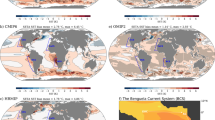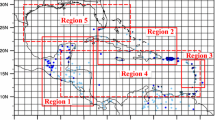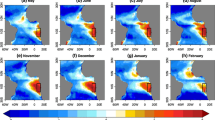Abstract
Despite decades of efforts and improvements in the representation of processes as well as in model resolution, current global climate models still suffer from a set of important, systematic biases in sea surface temperature (SST), not much different from the previous generation of climate models. Many studies have looked at errors in the wind field, cloud representation or oceanic upwelling in coupled models to explain the SST errors. In this paper we highlight the relationship between latent heat flux (LH) biases in forced atmospheric simulations and the SST biases models develop in coupled mode, at the scale of the entire intertropical domain. By analyzing 22 pairs of forced atmospheric and coupled ocean-atmosphere simulations from the CMIP5 database, we show a systematic, negative correlation between the spatial patterns of these two biases. This link between forced and coupled bias patterns is also confirmed by two sets of dedicated sensitivity experiments with the IPSL-CM5A-LR model. The analysis of the sources of the atmospheric LH bias pattern reveals that the near-surface wind speed bias dominates the zonal structure of the LH bias and that the near-surface relative humidity dominates the east–west contrasts.








Similar content being viewed by others
References
Bao S, Lin P, Zhou T, Liu Y, Yu Y, Wu G, He B, He J, Li L, Li J, Li Y, Liu H, Qiao F, Song Z, Wang B, Wang J, Wang P, Wang X, Wang Z, Wu B, Wu T, Xu Y, Yu H, Zhao W, Zheng W, Zhou L (2013) The flexible global ocean–atmosphere–land system model, Spectral Version 2: FGOALS-s2. Adv Atmos Sci 30(3):561–576
Batte L, Deque M (2011) Seasonal predictions of precipitation over Africa using coupled ocean–atmosphere general circulation models: skill of the ENSEMBLES project multimodel ensemble forecasts. Tellus-A 63:283–299. doi:10.1111/j.1600-0870.2010.00493.x
Bentsen M, Bethke I, Debernard JB, Iversen T, Kirkevåg A, Seland Ø, Drange H, Roelandt C, Seierstad IA, Hoose C, Kristjánsson JE (2012) The Norwegian earth system model, NorESM1-M. Part 1: Description and basic evaluation. Geosci Model Dev Discuss 5:28432931
Bi D, Dix M, Marsland S, O’Farrel S, Rashid H, Uotila P, Hirst T, Kowalczyk E, Golebiewski M, Sullivan A, Yan H, Hannah N, Sun CFZ, Vohralik P, Watterson I, Zhou X, Fiedler R, Collier M, Ma Y, Noonan J, Stevens L, Uhe P, Zhu H, Griffies S, Hill R, Harris C, Puri K (2013) The ACCESS coupled model: description, control climate and evaluation. Aust Meteorol Oceanogr J 63:41–64
Bourassa MA, Hughes PJ, Smith SR (2008) Surface turbulent flux product comparison. Flux News 5:22–24
Chang C, Carton J, Grodsky S, Nigam S (2007) Seasonal climate of the tropical Atlantic sector in the NCAR community climate system model 3: error structure and probable causes of errors. J Clim 20:1053–1070
Chaudhuri AH, Ponte RM, Forget G, Heimbach P (2013) A comparison of atmospheric reanalysis surface products over the ocean and implications for uncertainties in air-sea boundary forcing. J Clim 26(1):153–170
Coindreau O, Hourdin F, Haeffelin M, Mathieu A, Rio C (2007) A global climate model with strechable grid and nudging: a tool for assesment of physical parametrizations 135:1474–1489
da Silva A, Young AC, Levitus S (1994) Atlas of surface marine data 1994, volume 1.: Algorithms and procedures. Tech. Rep. 6, U.S. Department of Commerce, NOAA, NESDIS
Davey M, Huddleston M, Sperber K, Braconnot P, Bryan F, Chen D, Colman R, Cooper C, Cubasch U, Delecluse P, DeWitt D, Fairhead L, Flato G, Gordon C, Hogan T, Ji M, Kimoto M, Kitoh A, Knutson T, Latif M, Treut HL, Li T, Manabe S, Mechoso C, Meehl G, Power S, Roeckner E, Terray L, Vintzileos A, Washington RVBWW, Yoshikawa I, Yu JY, Yukimoto S, Zebiak S (2002) STOIC: a study of coupled model climatology and variability in tropical ocean regions. Clim Dyn 18:403–420. doi:10.1007/s00382-001-0188-6
Dee DP, Uppala SM, Simmons AJ, Berrisford P, Poli P, Kobayashi S, Andrae U, Balmaseda MA, Balsamo G, Bauer P, Bechtold P, Beljaars ACM, van de Berg L, Bidlot J, Bormann N, Delsol C, Dragani R, Fuentes M, Geer AJ, Healy LHSB, Hersbach H, Holm EVH, Isaksen L, Kållberg PK, Köhler M, Matricardi M, McNally AP, Monge-Sanz BM, Morcrette JJ, Park BK, Peubey C, de Rosnay P, Tavolato C, Thépaut JN, Vitart F (2011) The ERA-Interim reanalysis: configuration and performance of the data assimilation system. Q J R Meteorol Soc 137:553–597
Dufresne JL, Foujols MA, Denvil S, Caubel A, Marti O, Aumont O, Balkanski Y, Bekki S, Bellenger H, Benshila R, Bony S, Bopp L, Braconnot P, Brockmann P, Cadule P, Cheruy F, Codron F, Cozic A, Cugnet D, de Noblet N, Duvel JP, Ethé C, Fairhead L, Fichefet T, Flavoni S, Friedlingstein P, Grandpeix JY, Guez L, Guilyardi E, Hauglustaine D, Hourdin F, Idelkadi A, Ghattas J, Joussaume S, Kageyama M, Krinner G, Labetoulle S, Lahellec A, Lefebvre MP, Lefevre F, Levy C, Li ZX, Lloyd J, Lott F, Madec G, Mancip M, Marchand M, Masson S, Meurdesoif Y, Mignot J, Musat I, Parouty S, Polcher J, Rio C, Schulz M, Swingedouw D, Szopa S, Talandier C, Terray P, Viovy N, Vuichard N (2013) Climate change projections using the IPSL-CM5 earth system model: from CMIP3 to CMIP5. Clim Dyn 40(9–10):2123–2165
Gent PR, Danabasoglu G, Donner LJ, Holland MM, Hunke EC, Jayne SR, Lawrence DM, Neale RB, Rasch PJ, Vertenstein M, Worley PH, Yang ZL, Zhang M (2011) The community climate system model version 4. J Clim 24(19):4973–4991. doi:10.1175/2011JCLI4083.1
Giorgetta M, Jungclaus J, Reick C, Legutke S, Bader J, Böttinger M, Brovkin V, Crueger T, Esch M, Fieg K, Glushak K, Gayler V, Haak H, Hollweg HD, Ilyina T, Kinne S, Kornblueh L, Matei D, Mauritsen T, Mikolajewicz U, Mueller W, Notz D, Pithan F, Raddatz T, Rast S, Redler R, Roeckner E, Schmidt H, Schnur R, Segschneider J, Six K, Stockhause M, Timmreck C, Wegner J, Widmann H, Wieners KH, Claussen M, Marotzke J, Stevens B (2013) Climate and carbon cycle changes from 1850 to 2100 in MPI-ESM simulations for the coupled model intercomparison project phase 5. J Adv Model Earth Syst 5:572–597
Griffies SM, Winton M, Donner LJ, Horowitz LW, Downes SM, Farneti R, Gnanadesikan A, Hurlin WJ, Lee HC, Liang Z, Palter JB, Samuels BL, Wittenberg AT, Wyman BL, Yin J, Zadeh N (2011) The GFDL CM3 coupled climate model: characteristics of the ocean and sea ice simulations. J Clim 24(13):3520–3544. doi:10.1175/2011JCLI3964.1
Găinuşă-Bogdan A, Braconnot P, Servonnat J (2015) Using an ensemble data set of turbulent air-sea fluxes to evaluate the ipsl climate model in tropical regions. J Geophys Res Atmos 120(10):4483–4505. doi:10.1002/2014JD022985
Gulev SK, Josey SA, Bourassa M, Breivik LA, Cronin MF, Fairall C, Gille S, Kent EC, Lee CM, McPhaden MJ, Monteiro PMS, Schuster U, Smith SR, Trenberth KE, Wallace D, Woodruff SD (2010) Surface energy, CO2 fluxes and sea ice. In: Hall J, Harrison DE, Stammer D (eds) Proceedings of OceanObs’09: sustained ocean observations and information for society. ESA Publication WPP-306, Venice
Hourdin F, Frdric, Găinuşă-Bogdan A, Braconnot P, Dufresne JL, Traore A, Rio C (2015) Air moisture control on ocean surface temperature, hidden key to the warm bias enigma. Geophys Res Lette 42(24):10,885–10,893. doi:10.1002/2015GL066764
Hu Z, Huang B, Hou Y, Wang W, Yang F, Stan C, Schneider E (2011) Sensitivity of tropical climate low-level clouds in the NCEP climate forecast system. J Clim 36:1795–1811. doi:10.1007/s00382-010-0797-z
Hurrell JW, Hack JJ, Shea D, Caron JM, Rosinski J (2008) A new sea surface temperature and sea ice boundary dataset for the communityatmosphere model. J Clim 21:5145–5153
Jeffrey SJ, Rotstayn LD, Collier MA, Dravitzki SM, Hamalainen C, Moeseneder C, Wong KK, Syktus JI (2013) Australia’s CMIP5 submission using the CSIRO Mk3.6 model. Aust Meteorol Oceanogr J 63:1–13
Ji D, Wang L, Feng J, Wu Q, Cheng H, Zhang Q, Yang J, Dong W, Dai Y, Gong D, Zhang RH, Wang X, Liu J, Moore JC, Chen D, Zhou M (2014) Description and basic evaluation of Beijing Normal University Earth System Model (BNU-ESM) version 1. Geosci Model Dev 7(5):2039–2064. doi:10.5194/gmd-7-2039-2014
Josey SA, Berry DI (2010) Air-sea fuxes of heat and freshwater. In: MCCIP Annual Report Card 2010-11, MCCIP Science Review
Kay JE, Deser C, Phillips A, Mai A, Hannay C, Strand G, Arblaster JM, Bates SC, Danabasoglu G, Edwards J, Holland M, Kushner P, Lamarque JF, Lawrence D, Lindsay K, Middleton A, Munoz E, Neale R, Oleson K, Polvani L, Vertenstein M (2015) The community earth system model (CESM) large ensemble project: a community resource for studying climate change in the presence of internal climate variability. Bull Am Meteorol Soc 96(8):1333–1349. doi:10.1175/BAMS-D-13-00255.1
Kumar BP, Vialard J, Lengaigne M, Murty VSN, McPhaden MJ (2012) TropFlux: air–sea fluxes for the global tropical oceans-description and evaluation. Clim Dyn 38(7–8):1521–1543
Li G, Xie SP (2012) Origins of tropical-wide sst biases in cmip multi-model ensembles. Geophys Res Lett 39(22). doi:10.1029/2012GL053777
Li L, Lin P, Yu Y, Wang B, Zhou T, Liu L, Liu J, Bao Q, Xu S, Huang W, Xia K, Pu Y, Dong L, Shen S, Liu Y, Hu N, Liu M, Sun W, Shi X, Zheng W, Wu B, Song M, Liu H, Zhang X, Wu G, Xue W, Huang X, Yang G, Song Z, Qiao F (2013) The flexible global ocean-atmosphere-land system model, Grid-point Version 2: FGOALS-g2. Adv Atmos Sci 30(3):543–560. doi:10.1007/s00376-012-2140-6
Lin JL (2007) The double-ITCZ problem in IPCC AR4 coupled GCMs: ocean–atmosphere feedback analysis. J Clim 20:4497–4525. doi:10.1175/JCLI4272.1
Mechoso CR, Robertson A, Barth N, Davey M, Delecluse P, Gent P, Ineson S, Kirtman B, Latif M, Treut HL (1995) The seasonal cycle over the tropical Pacific in coupled ocean-atmosphere general circulation models. Mon Weather 9(123):2825–2838. doi:10.1175/1520-0493(1995)
Reichler T, Kim J (2008) How well do coupled models simulate todays climate? Bull Am Meteorol Soc 89(303). doi:10.1175/BAMS-89-3-303
Richter I (2015) Climate model biases in the eastern tropical oceans: causes, impacts and ways forward. Clim Change 6:345–358. doi:10.1002/wcc.338
Richter I, Xie SP (2008) On the origin of equatorial Atlantic biases in coupled general circulation models. Clim Dyn 31:587–598. doi:10.1007/s00382-008-0364-z
Roehrig R, Bouniol D, Guichard F, Hourdin F, Redelsperger JL (2013) The present and future of the west african monsoon: a process-oriented assessment of cmip5 simulations along the amma transect. Clim Dyn 26:6471–6505. doi:10.1175/JCLI-D-12-00505.1
Scoccimarro E, Gualdi S, Bellucci A, Sanna A, Fogli PG, Manzini E, Vichi M, Oddo P, Navarra A (2011) Effects of tropical cyclones on ocean heat transport in a high resolution coupled general circulation model. J Clim 24:4368–4384
Smith SR, Hughes PJ, Bourassa MA (2011) A comparison of nine monthly air–sea flux products. Int J Climatol 31(7):1002–1027
Szoeke SD, Xie SP (2008) The tropical eastern Pacific seasonal cycle: assessment of errors and mechanisms in IPCC AR4 coupled ocean-atmosphere general circulation models. J Clim 21:2573–2590. doi:10.1175/2007JCLI1975.1
Taylor KE, Williamson D, Zwiers F (2000) The sea surface temperature and sea-ice concentration boundary conditions for AMIP II simulations. PCMDI report 60, Program for Climate Model Diagnosis and Intercomparison, Lawrence Livermore National Laboratory, Livermore, California
Taylor KE, Stouffer RJ, Meehl GA (2012) An overview of CMIP5 and the experiment design. Bull Am Meteorol Soc 93(4):485–498
Tomita H, Kubota M, Cronin MF, Iwasaki S, Konda M, Ichikawa H (2010) An assessment of surface heat fluxes from J-OFURO2 at the KEO and JKEO sites. J Geophys Res 115(C03):018
Vanniere BE, Guilyardi E, Toniazzo T, Madec G, Woolhough S (2014) A systematic approach to identify the sources of tropical SST errors in coupled models using the adjust- ment of initialised experiments. Clim Dyn 43:2261–2282. doi:10.1007/s00382-014-2051-6
Voldoire A, Sanchez-Gomez E, y Mélia DS, Decharme B, Cassou C, Sénési S, Valcke S, Beau I, Alias A, Chevallier M, Déqué M, Deshayes J, Douville H, Fernandez E, Madec G, Maisonnave E, Moine MP, Planton S, Saint-Martin D, Szopa S, Tyteca S, Alkama R, Belamari S, Braun A, Coquart L, Chauvin F (2013) The CNRM-CM5.1 global climate model: description and basic evaluation. Clim Dyn 40(9):2091–2121
Voldoire A, Claudon M, Caniaux G, Giordani H, Roehrig R (2014) Are atmospheric biases responsible for the tropical Atlantic SST biases in the CNRM-CM5 coupled model? Clim Dyn 43(11):2963–2984
Volodin EM, Dianskii NA, Gusev AV (2010) Simulating present-day climate with the INMCM4.0 coupled model of the atmospheric and oceanic general circulations. Izvestiya, Atmospheric and Oceanic. Physics 46(4):414–431. doi:10.1134/S000143381004002X
Wahl S, Latif M, Park W, Keenlyside N (2011) On the tropical Atlantic SST warm bias in the Kiel climate model. Clim Dyn 36:891–906
Watanabe M, Suzuki T, Oishi R, Komuro Y, Watanabe S, Emori S, Takemura T, Chikira M, Ogura T, Sekiguchi M, Takata K, Yamazaki D, Yokohata T, Nozawa T, Hasumi H, Tatebe H, Kimoto M (2010) Improved Climate Simulation by MIROC5: Mean States, Variability, and Climate Sensitivity. J Clim 23(23):6312–6335. doi:10.1175/2010JCLI3679.1
WCRP (2000) Intercomparison and validation of ocean-atmosphere energy flux fields. final report of the Joint WCRP/SCOR Working Group on Air-Sea Fluxes (SCOR Working Group 110). Tech. Rep. WCRP-112 (WMO/TD-1036), World Meteorological Organization, World Climate Research Programme, Geneva, Switzerland
Xin XG, Wu TW, Zhang J (2013) Introduction of CMIP5 experiments carried out with the climate system models of Beijing Climate Center. Adv Clim Change Res 4(1):41–49
Xu Z, Chang P, Richter I, Kim W, Tang G (2014a) Diagnosing southeast tropical Atlantic SST and ocean circulation biases in the CMIP5 ensemble. Clim Dyn 43:3123–3145. doi:10.1007/s00382-014-2247-9
Yukimoto S, Adachi Y, Hosaka M, Sakami T, Yoshimura H, Hirabara M, Tanaka TY, Shindo E, Tsujino H, Delushi M, Mizuta R, Yabu S, Obata A, Nakano H, Koshiro T, Ose T, Kitch A (2012) A new global climate model of the Meteorological Research Institute: MRI-CGCM3 model description and basic performance. J Meteorol Soc Jpn 90A:2364
Zheng Y, Shinoda T, Lin JL, Kiladis GN (2011) Sea Surface Temperature Biases under the Stratus Cloud Deck in the Southeast Pacific Ocean in 19 IPCC AR4 Coupled general circulation models. J Clim 24:4139–4164. doi:10.1175/2011JCLI4172.1
Acknowledgements
We wish to thank Jean-Louis Dufresne for the fruitful discussions in the early stages of this work which have helped shape the CMIP5 analysis. We also wish to thank Lidia Mellul and Jérôme Servonnat for providing the wind-nudged simulations used in this study. We acknowledge the World Climate Research Programme’s Working Group on Coupled Modelling, which is responsible for CMIP, and we thank the climate modeling groups (listed in Table 1 of this paper) for producing and making available their model output. For CMIP the U.S. Department of Energy’s Program for Climate Model Diagnosis and Intercomparison provides coordinating support and led development of software infrastructure in partnership with the Global Organization for Earth System Science Portals. For the access and analysis of the CMIP5 data, we have benefited from the IPSL Prodiguer-Ciclad facility, supported by CNRS, UPMC, and Labex L-IPSL which is funded by the ANR (Grant ANR-10-LABX-0018) and by the European FP7 IS-ENES2 project (Grant 312979). The research leading to these results received funding from the EU FP7/2007-2013 under grant agreement no. 603521 and benefited as well from support of the ANR project "CONVERGENCE" (N8ANR-13-MONU-0008). Finally, we are extremely grateful to Olivier Boucher for providing financial support for this work through the MACC II project.
Author information
Authors and Affiliations
Corresponding author
Appendix: Computation of explained variance
Appendix: Computation of explained variance
In order to calculate the variance of pattern A (e.g., the CPL SST bias pattern) explained by pattern B (e.g., the AMIP LH bias pattern), we project pattern A on pattern B. We first normalise B so as to obtain a representative unit vector, perform the vector projection and then compare the variance represented by this projection to the total variance of pattern A.
In practice, this consists of considering vectors \(\mathbf {a}\) and \(\mathbf {b}\) containing the ordered sequences of grid point values corresponding to A and B, respectively. We calculate the projection of \(\mathbf {a}\) on \(\mathbf {b}\), \(\mathbf {a_b}\), as:
where
We then calculate the associated proportion of explained variance as the squared norm of the projection divided by the squared norm of \(\mathbf {a}\), i.e., \(\dfrac{\Vert \mathbf {a_b}\Vert ^2}{\Vert \mathbf {a}\Vert ^2}\).
This process is mathematically equivalent to calculating \(\dfrac{(\mathbf {a}\cdot \mathbf {b})^2}{(\mathbf {a}\cdot \mathbf {a})(\mathbf {b}\cdot \mathbf {b})}\).
Rights and permissions
About this article
Cite this article
Găinuşă-Bogdan, A., Hourdin, F., Traore, A.K. et al. Omens of coupled model biases in the CMIP5 AMIP simulations. Clim Dyn 51, 2927–2941 (2018). https://doi.org/10.1007/s00382-017-4057-3
Received:
Accepted:
Published:
Issue Date:
DOI: https://doi.org/10.1007/s00382-017-4057-3




